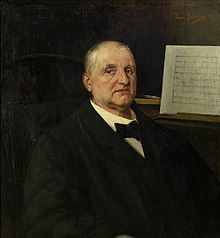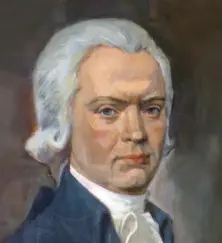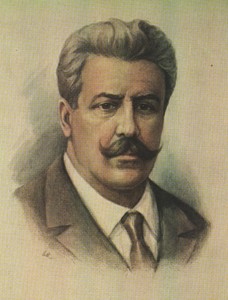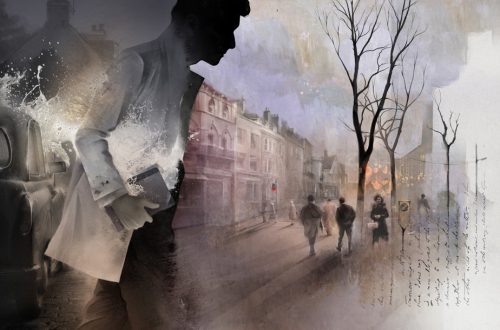
Anton Bruckner |
Anton Bruckner
A mystic-pantheist, endowed with the linguistic power of Tauler, the imagination of Eckhart, and the visionary fervor of Grunewald, in the XNUMXth century is truly a miracle! O. Lang
Disputes about the true meaning of A. Bruckner do not stop. Some see him as a “Gothic monk” who miraculously resurrected in the era of romanticism, others perceive him as a boring pedant who composed symphonies one after another, similar to each other like two drops of water, long and sketchy. The truth, as always, lies far from extremes. The greatness of Bruckner lies not so much in the devout faith that permeates his work, but in the proud, unusual for Catholicism idea of man as the center of the world. His works embody the idea becoming, a breakthrough to apotheosis, striving for the light, unity with a harmonized cosmos. In this sense, he is not alone in the nineteenth century. – it is enough to recall K. Brentano, F. Schlegel, F. Schelling, later in Russia – Vl. Solovyov, A. Scriabin.
On the other hand, as a more or less careful analysis shows, the differences between Bruckner’s symphonies are quite noticeable. First of all, the composer’s enormous capacity for work is striking: being busy teaching for about 40 hours a week, he composed and reworked his works, sometimes beyond recognition, and, moreover, at the age of 40 to 70 years. In total, we can talk not about 9 or 11, but about 18 symphonies created in 30 years! The fact is that, as it turned out as a result of the work of the Austrian musicologists R. Haas and L. Novak on the publication of the complete works of the composer, the editions of 11 of his symphonies are so different that each of them should be recognized as valuable in itself. V. Karatygin said well about understanding the essence of Bruckner’s art: “Complex, massive, basically having titanic artistic concepts and always cast in large forms, Bruckner’s work requires from the listener who wants to penetrate the inner meaning of his inspirations, a significant intensity of apperceptional work, powerful active-volitional impulse, going towards the high-rising billows of the actual-volitional anergy of Bruckner’s art.
Bruckner grew up in the family of a peasant teacher. At the age of 10 he began to compose music. After the death of his father, the boy was sent to the choir of St. Florian’s monastery (1837-40). Here he continued to study the organ, piano and violin. After a short study in Linz, Bruckner began working as a teacher’s assistant in the village school, he also worked part-time in rural jobs, played at dance parties. At the same time he continued to study composition and playing the organ. Since 1845 he has been a teacher and organist at the monastery of St. Florian (1851-55). Since 1856, Bruckner has been living in Linz, serving as an organist in the cathedral. At this time, he completes his composing education with S. Zechter and O. Kitzler, travels to Vienna, Munich, meets R. Wagner, F. Liszt, G. Berlioz. In 1863, the first symphonies appear, followed by masses – Bruckner became a composer at 40! So great was his modesty, strictness towards himself, that until that time he did not allow himself to even think about large forms. Bruckner’s fame as an organist and unsurpassed master of organ improvisation is growing. In 1868 he received the title of court organist, became a professor at the Vienna Conservatory in the class of bass general, counterpoint and organ, and moved to Vienna. From 1875 he also lectured on harmony and counterpoint at the University of Vienna (H. Mahler was among his students).
Recognition for Bruckner as a composer came only at the end of 1884, when A. Nikisch first performed his Seventh Symphony in Leipzig with great success. In 1886, Bruckner played the organ during Liszt’s funeral ceremony. At the end of his life, Bruckner was seriously ill for a long time. He spent his last years working on the Ninth Symphony; having retired, he lived in an apartment provided to him by Emperor Franz Joseph in the Belvedere Palace. The ashes of the composer are buried in the church of the monastery of St. Florian, under the organ.
Peru Bruckner owns 11 symphonies (including F minor and D minor, “Zero”), a string Quintet, 3 masses, “Te Deum”, choirs, pieces for organ. For a long time the most popular were the Fourth and Seventh symphonies, the most harmonious, clear and easy to perceive directly. Later, the interest of the performers (and the listeners along with them) shifted to the Ninth, Eighth, and Third symphonies – the most conflicting, close to the “Beethovenocentrism” common in the interpretation of the history of symphonism. Along with the appearance of the complete collection of the composer’s works, the expansion of knowledge about his music, it became possible to periodize his work. The first 4 symphonies form an early stage, the peak of which was the colossal pathetic Second Symphony, the heir to the impulses of Schumann and the struggles of Beethoven. Symphonies 3-6 constitute the central stage during which Bruckner reaches the great maturity of pantheistic optimism, which is not alien to either emotional intensity or volitional aspirations. The bright Seventh, the dramatic Eighth and the tragically enlightened Ninth are the last stage; they absorb many features of the previous scores, although they differ from them by a much longer length and slowness of the titanic deployment.
The touching naivete of Bruckner the man is legendary. Collections of anecdotal stories about him have been published. The difficult struggle for recognition left a certain imprint on his psyche (fear of E. Hanslik’s critical arrows, etc.). The main content of his diaries were notes about the prayers read. Answering a question about the initial motives for writing “Te Deum’a” (a key work for understanding his music), the composer replied: “In gratitude to God, since my persecutors have not yet succeeded in destroying me … I want when the day of judgment will be , give the Lord the score of “Te Deum’a” and say: “Look, I did this only for you alone!” After that, I’ll probably slip through. The naive efficiency of a Catholic in calculations with God also appeared in the process of working on the Ninth Symphony – dedicating it to God in advance (a unique case!), Bruckner prayed: “Dear God, let me get well soon! Look, I need to be healthy to finish the Ninth!”
The current listener is attracted by the exceptionally effective optimism of Bruckner’s art, which goes back to the image of the “sounding cosmos”. The powerful waves built with inimitable skill serve as a means of achieving this image, striving towards the apotheosis that concludes the symphony, ideally (as in the Eighth) collecting all its themes. This optimism distinguishes Bruckner from his contemporaries and gives his creations a symbolic meaning – the features of a monument to the unshakable human spirit.
G. Pantielev
Austria has long been famous for its highly developed symphonic culture. Due to special geographical and political conditions, the capital of this major European power enriched its artistic experience with the search for Czech, Italian and North German composers. Under the influence of the ideas of the Enlightenment, on such a multinational basis, the Viennese classical school was formed, the largest representatives of which in the second half of the XNUMXth century were Haydn and Mozart. He brought a new stream to European symphonism German Beethoven. inspired by ideas french Revolution, however, he began to create symphonic works only after he settled in the capital of Austria (the First Symphony was written in Vienna in 1800). Schubert at the beginning of the XNUMXth century consolidated in his work – already from the standpoint of romanticism – the highest achievements of the Viennese symphony school.
Then came the years of reaction. Austrian art was ideologically petty – it failed to respond to the vital issues of our time. The everyday waltz, for all the artistic perfection of its embodiment in Strauss’s music, supplanted the symphony.
A new wave of social and cultural upsurge emerged in the 50s and 60s. By this time, Brahms had moved from the north of Germany to Vienna. And, as was the case with Beethoven, Brahms also turned to symphonic creativity precisely on Austrian soil (the First Symphony was written in Vienna in 1874-1876). Having learned a lot from the Viennese musical traditions, which in no small measure contributed to their renewal, he nevertheless remained a representative German artistic culture. Actually Austrian the composer who continued in the field of symphony what Schubert did at the beginning of the XNUMXth century for Russian musical art was Anton Bruckner, whose creative maturity came in the last decades of the century.
Schubert and Bruckner – each in a different way, in accordance with their personal talent and their time – embodied the most characteristic features of Austrian romantic symphonism. First of all, they include: a strong, soil connection with the surrounding (mainly rural) life, which is reflected in the rich use of song and dance intonations and rhythms; a propensity for lyrical self-absorbed contemplation, with bright flashes of spiritual “insights” – this, in turn, gives rise to a “sprawling” presentation or, using Schumann’s well-known expression, “divine lengths”; a special warehouse of leisurely epic narration, which, however, is interrupted by a stormy revelation of dramatic feelings.
There are also some commonalities in personal biography. Both are from a peasant family. Their fathers are rural teachers who intended their children for the same profession. Both Schubert and Bruckner grew up and matured as composers, living in an environment of ordinary people, and most fully revealed themselves in communication with them. An important source of inspiration was also nature – mountain forest landscapes with numerous picturesque lakes. Finally, both of them lived only for music and for the sake of music, creating directly, rather on a whim than at the behest of reason.
But, of course, they are also separated by significant differences, primarily due to the course of the historical development of Austrian culture. “Patriarchal” Vienna, in the philistine clutches of which Schubert suffocated, turned into a large capitalist city – the capital of Austria-Hungary, torn apart by sharp socio-political contradictions. Other ideals than in Schubert’s time were put forward by modernity before Bruckner – as a major artist, he could not but respond to them.
The musical environment in which Bruckner worked was also different. In his individual inclinations, gravitating towards Bach and Beethoven, he was most of all fond of the new German school (bypassing Schumann), Liszt, and especially Wagner. Therefore, it is natural that not only the figurative structure, but also the musical language of Bruckner should have become different in comparison with Schubert’s. This difference was aptly formulated by I. I. Sollertinsky: “Bruckner is Schubert, clad in a shell of brass sounds, complicated by elements of Bach’s polyphony, the tragic structure of the first three parts of Beethoven’s Ninth Symphony and Wagner’s “Tristan” harmony.”
“Schubert of the second half of the XNUMXth century” is how Bruckner is often called. Despite its catchiness, this definition, like any other figurative comparison, still cannot give an exhaustive idea of the essence of Bruckner’s creativity. It is much more contradictory than Schubert’s, because in the years when the tendencies of realism strengthened in a number of national musical schools in Europe (first of all, of course, we remember the Russian school!), Bruckner remained a romantic artist, in whose worldview progressive features were intertwined with vestiges of the past. Nevertheless, his role in the history of the symphony is very great.
* * *
Anton Bruckner was born on September 4, 1824 in a village located near Linz, the main city of Upper (that is, northern) Austria. Childhood passed in need: the future composer was the eldest among the eleven children of a modest village teacher, whose leisure hours were decorated with music. From an early age, Anton helped his father in school, and he taught him to play the piano and violin. At the same time, there were classes on the organ – Anton’s favorite instrument.
At the age of thirteen, having lost his father, he had to lead an independent working life: Anton became a chorister of the choir of the monastery of St. Florian, soon entered courses that trained folk teachers. At the age of seventeen, his activity in this field begins. Only in fits and starts does he manage to make music; but the holidays are entirely devoted to her: the young teacher spends ten hours a day at the piano, studying the works of Bach, and plays the organ for at least three hours. He tries his hand at composition.
In 1845, having passed the prescribed tests, Bruckner received a teaching position in St. Florian – in the monastery, located near Linz, where he himself had once studied. He also performed the duties of an organist and, using the extensive library there, replenished his musical knowledge. However, his life was not joyful. “I don’t have a single person to whom I could open my heart,” wrote Bruckner. “Our monastery is indifferent to music and, consequently, to musicians. I cannot be cheerful here and no one should know about my personal plans. For ten years (1845-1855) Bruckner lived in St. Florian. During this time he wrote over forty works. (In the previous decade (1835-1845) – about ten.) — choral, organ, piano and others. Many of them were performed in the vast, richly decorated hall of the monastery church. The improvisations of the young musician on the organ were especially famous.
In 1856 Bruckner was called to Linz as cathedral organist. Here he stayed for twelve years (1856-1868). School pedagogy is over – from now on you can devote yourself entirely to music. With rare diligence, Bruckner devotes himself to studying the theory of composition (harmony and counterpoint), choosing as his teacher the famous Viennese theorist Simon Zechter. On the instructions of the latter, he writes mountains of musical paper. Once, having received another portion of the completed exercises, Zechter answered him: “I looked through your seventeen notebooks on double counterpoint and was amazed at your diligence and your successes. But in order to preserve your health, I ask you to give yourself a rest … I am forced to say this, because so far I have not had a student equal to you in diligence. (By the way, this student was about thirty-five years old at the time!)
In 1861, Bruckner passed tests in organ playing and theoretical subjects at the Vienna Conservatory, arousing the admiration of the examiners with his performing talent and technical dexterity. From the same year, his familiarization with new trends in the art of music begins.
If Sechter brought up Bruckner as a theorist, then Otto Kitzler, a Linz theater conductor and composer, an admirer of Schumann, Liszt, Wagner, managed to direct this fundamental theoretical knowledge into the mainstream of modern artistic research. (Before that, Bruckner’s acquaintance with romantic music was limited to Schubert, Weber and Mendelssohn.) Kitzler believed that it would take at least two years to introduce his student, who was on the verge of forty years, to them. But nineteen months passed, and again the diligence was unparalleled: Bruckner perfectly studied everything that his teacher had at his disposal. The protracted years of study were over – Bruckner was already more confidently looking for his own ways in art.
This was helped by acquaintance with Wagnerian operas. A new world opened up to Bruckner in the scores of The Flying Dutchman, Tannhäuser, Lohengrin, and in 1865 he attended the premiere of Tristan in Munich, where he made a personal acquaintance with Wagner, whom he idolized. Such meetings continued later – Bruckner recalled them with reverent delight. (Wagner treated him patronizingly and in 1882 said: “I know only one who approaches Beethoven (it was about symphonic work. – M. D.), this is Bruckner …”.). One can imagine with what amazement, which transformed the usual musical performances, he first got acquainted with the overture to Tannhäuser, where the choral melodies so familiar to Bruckner as a church organist acquired a new sound, and their power turned out to be opposed to the sensual charm of the music depicting the Venus Grotto! ..
In Linz, Bruckner wrote over forty works, but their intentions are larger than was the case in the works created in St. Florian. In 1863 and 1864 he completed two symphonies (in f minor and d minor), although he later did not insist on performing them. The first serial number Bruckner designated the following symphony in c-moll (1865-1866). Along the way, in 1864-1867, three great masses were written – d-moll, e-moll and f-moll (the latter is the most valuable).
Bruckner’s first solo concert took place in Linz in 1864 and was a great success. It seemed that now comes a turning point in his fate. But that did not happen. And three years later, the composer falls into depression, which is accompanied by a serious nervous illness. Only in 1868 did he manage to get out of the provincial province – Bruckner moved to Vienna, where he remained until the end of his days for more than a quarter of a century. This is how it opens third period in his creative biography.
An unprecedented case in the history of music – only by the middle of the 40s of his life the artist fully finds himself! After all, the decade spent in St. Florian can only be regarded as the first timid manifestation of a talent that has not yet matured. Twelve years in Linz – years of apprenticeship, mastery of the trade, technical improvement. By the age of forty, Bruckner had not yet created anything significant. The most valuable is the organ improvisations that remained unrecorded. Now, the modest craftsman has suddenly turned into a master, endowed with the most original individuality, original creative imagination.
However, Bruckner was invited to Vienna not as a composer, but as an excellent organist and theorist, who could adequately replace the deceased Sechter. He is forced to devote a lot of time to music pedagogy – a total of thirty hours a week. (At the Vienna Conservatory, Bruckner taught classes in harmony (general bass), counterpoint and organ; at the Teachers’ Institute he taught piano, organ and harmony; at the university – harmony and counterpoint; in 1880 he received the title of professor. Among Bruckner’s students – who later became conductors A Nikish, F. Mottl, brothers I. and F. Schalk, F. Loewe, pianists F. Eckstein and A. Stradal, musicologists G. Adler and E. Decey, G. Wolf and G. Mahler were close with Bruckner for some time .) The rest of his time he spends composing music. During the holidays, he visits the rural areas of Upper Austria, which are so fond of him. Occasionally he travels outside his homeland: for example, in the 70s he toured as an organist with great success in France (where only Cesar Franck can compete with him in the art of improvisation!), London and Berlin. But he is not attracted by the bustling life of a big city, he does not even visit theaters, he lives closed and lonely.
This self-absorbed musician had to experience many hardships in Vienna: the path to recognition as a composer was extremely thorny. He was sneered at by Eduard Hanslik, the indisputable musical-critical authority of Vienna; the latter was echoed by tabloid critics. This is largely due to the fact that the opposition to Wagner was strong here, while the worship of Brahms was considered a sign of good taste. However, the shy and modest Bruckner is inflexible in one thing – in his attachment to Wagner. And he became a victim of a fierce feud between the “Brahmins” and the Wagnerians. Only a persistent will, brought up by diligence, helped Bruckner to survive in the struggle of life.
The situation was further complicated by the fact that Bruckner worked in the same field in which Brahms gained fame. With rare tenacity, he wrote one symphony after another: from the Second to the Ninth, that is, he created his best works for about twenty years in Vienna. (In total, Bruckner wrote over thirty works in Vienna (mostly in large form).). Such a creative rivalry with Brahms caused even sharper attacks on him from the influential circles of the Viennese musical community. (Brahms and Bruckner avoided personal meetings, treated each other’s work with hostility. Brahms ironically called Bruckner’s symphonies “giant snakes” for their immense length, and he said that any waltz by Johann Strauss was dearer to him than Brahms’s symphonic works (although he spoke sympathetically about his First piano concerto).
It is not surprising that prominent conductors of the time refused to include Bruckner’s works in their concert programs, especially after the sensational failure of his Third Symphony in 1877. As a result, for many years the already far from young composer had to wait until he could hear his music in orchestral sound. Thus, the First Symphony was performed in Vienna only twenty-five years after its completion by the author, the Second waited twenty-two years for its performance, the Third (after the failure) – thirteen, the Fourth – sixteen, the Fifth – twenty-three, the Sixth – eighteen years. The turning point in the fate of Bruckner came in 1884 in connection with the performance of the Seventh Symphony under the direction of Arthur Nikisch – glory finally comes to the sixty-year-old composer.
The last decade of Bruckner’s life was marked by a growing interest in his work. (However, the time for Bruckner’s full recognition has not yet come. It is significant, for example, that in his entire long life he heard only twenty-five times the performance of his own major works.). But old age is approaching, the pace of work slows down. Since the beginning of the 90s, health has been deteriorating – dropsy is intensifying. Bruckner dies October 11, 1896.
M. Druskin
- Symphonic works of Bruckner →





